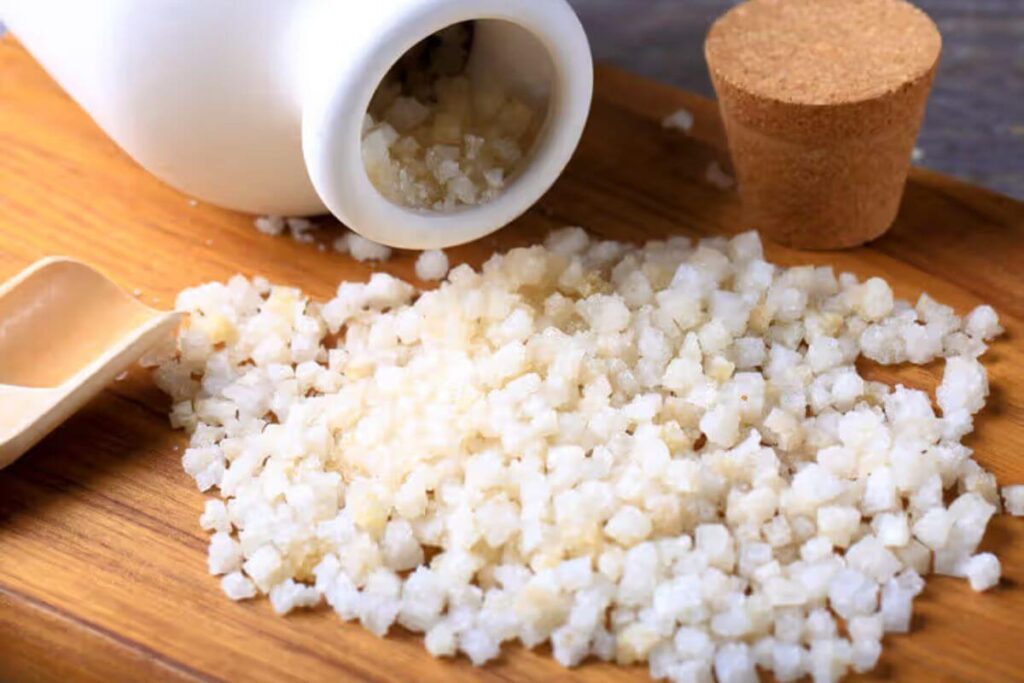The soothing ritual of a warm bath has been a cherished part of infant care for generations. However, when it comes to incorporating Epsom salt into an infant’s bath routine, questions and concerns may arise. In this comprehensive guide, we explore the potential benefits, precautions, and best practices for giving your infant an Epsom salt bath.
Understanding Epsom Salt: A Mineral Marvel
Epsom salt, chemically known as magnesium sulfate, is a naturally occurring mineral with a crystalline structure. Widely recognized for its potential therapeutic properties, Epsom salt has gained popularity for its use in baths, claiming benefits ranging from muscle relaxation to skin health.

The Potential Benefits for Infants:
Skin Soothing Properties:
Epsom salt is believed to have skin-soothing properties, making it potentially beneficial for infants with minor skin irritations or sensitivities.
Mild Relaxation:
The magnesium in Epsom salt is thought to contribute to muscle relaxation. For a fussy or restless infant, an Epsom salt bath might offer a calming effect.
Hydration Support:
Epsom salt baths may assist in maintaining skin hydration, potentially beneficial for infants with dry skin.
Best Practices for Preparing an Epsom Salt Bath for Infants:
Consultation with Healthcare Provider:
Before introducing Epsom salt baths, consult with your pediatrician or healthcare provider to ensure it aligns with your infant’s individual health needs.
Choosing High-Quality Epsom Salt:
Opt for high-quality Epsom salt without additives or fragrances to provide a pure and gentle bathing experience.
Appropriate Dosage:
Follow recommended guidelines for Epsom salt usage. In most cases, a minimal amount, such as half a cup for a standard-sized baby bathtub, is sufficient.
Thorough Dissolution:
Ensure the Epsom salt dissolves completely in warm water before placing your infant in the bath. This ensures even distribution and avoids any discomfort from undissolved crystals.
Short Bath Duration:
Limit the duration of the Epsom salt bath to a short period, typically around 5-10 minutes, to prevent overexposure.
Avoid Fragrances or Additives:
Steer clear of scented Epsom salts or additional additives that may irritate an infant’s sensitive skin.
Precautions and Considerations:
Skin Sensitivity:
Every infant’s skin is unique. Conduct a patch test before introducing Epsom salt baths to ensure there are no adverse reactions.
Monitoring Infant’s Reaction:
Observe your infant’s reaction during and after the bath. If you notice any signs of discomfort or irritation, discontinue use and consult with your healthcare provider.
Water Temperature:
Maintain a moderate water temperature to avoid causing thermal discomfort to the infant.
Conclusion: A Gentle Addition to Infant Care
While Epsom salt baths may offer potential benefits for infants, it’s crucial to approach them with caution and under the guidance of healthcare professionals. Individual reactions may vary, and what works for one infant may not be suitable for another.
Incorporating Epsom salt baths into your infant care routine can be a gentle and soothing experience when done mindfully. Prioritize your infant’s safety and well-being, and always seek professional advice when in doubt.
Elevating the Infant Bath Experience: Tips for Maximum Comfort
As you embark on the journey of introducing Epsom salt baths to your infant’s routine, consider the following tips to enhance the experience and ensure maximum comfort:
1. Gentle Support During the Bath:
- Use a soft, supportive baby bath insert or cushion to cradle your infant comfortably during the bath. This provides added support and a sense of security.
2. Engage in Soothing Interaction:
- Make the bath a bonding experience by engaging in gentle interaction. Sing lullabies, talk softly, and maintain eye contact to create a calming atmosphere.
3. Optimal Timing for Epsom Salt Baths:
- Choose a time when your infant is generally calm and not too hungry. A well-timed bath can contribute to a positive experience.
4. Incorporate Soft Towels and Blankets:
- Have soft, warm towels and blankets ready for post-bath cuddles. The cozy wrap provides an additional layer of comfort for your infant.
5. Introduce Soft Music or White Noise:
- Consider playing soft music or white noise during the bath. The gentle sounds can further enhance the calming effect of the Epsom salt bath.
6. Follow with a Gentle Massage:
- After the bath, engage in a gentle massage using baby-safe lotion. This not only helps in maintaining skin hydration but also adds an extra element of relaxation.
7. Mindful Breathing for Both Parent and Infant:
- Practice mindful breathing during the bath. Create a serene environment by regulating your breath, which can positively influence your infant’s mood.
8. Gradual Introduction to Epsom Salt Baths:
- Start with shorter sessions and gradually increase the duration as your infant becomes accustomed to the Epsom salt baths. Pay attention to any cues of discomfort or unease.
9. Soft Lighting for a Relaxing Ambiance:
- Use soft, dim lighting to create a serene ambiance during the bath. Avoid harsh lights that may be overwhelming for your infant.
10. Experiment with Different Epsom Salt Types:
- Some Epsom salts come in various formulations, such as lavender-infused or chamomile-infused options. Experiment with different types to see which scent resonates best with your infant.
Additional Considerations:
1. Regular Monitoring of Skin Condition:
- Keep a close eye on your infant’s skin condition, especially if there are any existing skin concerns. If irritation persists, consult with your healthcare provider.
2. Trust Your Parental Instincts:
- You know your infant best. Trust your instincts and adapt the bath routine based on your infant’s individual preferences and comfort levels.
3. Enjoy the Experience Together:
- Lastly, cherish the moments of bath time with your infant. It’s not just about the potential benefits of Epsom salt but also about creating positive and soothing memories together.
Remember, every infant is unique, and what works well for one may not be the same for another. By incorporating these tips and paying close attention to your infant’s cues, you can make Epsom salt baths a delightful and relaxing addition to your baby’s routine.
Frequently Asked Questions (FAQs) About Epsom Salt Baths for Infants
Q1: Can I use any type of Epsom salt for my infant’s bath?
Answer: It’s advisable to choose high-quality, pure Epsom salt without additives or fragrances. Avoid scented varieties and opt for those specifically labeled as suitable for infants.
Q2: How often can I give my infant an Epsom salt bath?
Answer: The frequency depends on your infant’s needs and individual tolerance. Start with once a week and observe how your baby reacts. Consult with your pediatrician for personalized guidance.
Q3: Are there any signs that my infant may be reacting negatively to the Epsom salt bath?
Answer: Watch for signs of irritation, redness, or discomfort during or after the bath. If you notice any adverse reactions, discontinue use and consult with your healthcare provider.
Q4: Can Epsom salt baths help with diaper rash?
Answer: While Epsom salt baths may offer relief for minor skin irritations, consult with your pediatrician for specific advice on treating diaper rash.
Q5: Can I use other additives like essential oils in my infant’s Epsom salt bath?
Answer: It’s recommended to avoid additional additives, including essential oils, for infants with sensitive skin. Stick to plain, high-quality Epsom salt to minimize the risk of irritation.
Q6: Is it safe to give my infant an Epsom salt bath if they have eczema?
Answer: Consult with your healthcare provider before introducing Epsom salt baths for infants with eczema or other skin conditions. Individual recommendations may vary.
Q7: How can I ensure the Epsom salt dissolves completely in the bathwater?
Answer: Stir the Epsom salt thoroughly in warm water and ensure it dissolves completely before placing your infant in the bath. This prevents any undissolved crystals from causing discomfort.
Q8: Can I use Epsom salt baths as a remedy for colic in my infant?
Answer: While Epsom salt baths may have a calming effect, it’s essential to address colic under the guidance of your pediatrician. Consult with them for appropriate colic management.
Q9: At what age can I start giving my infant Epsom salt baths?
Answer: It’s generally safe to introduce Epsom salt baths when your infant’s umbilical stump has healed and falls off. However, consult with your pediatrician for personalized advice based on your baby’s development.
Q10: Are there any alternatives to Epsom salt for soothing an infant’s skin?
Answer: Alternatives include plain warm water baths or mild baby-approved bath products. Consult with your pediatrician to find the most suitable option for your infant’s skin.
Feel free to reach out if you have additional questions or need further clarification on Epsom salt baths for infants.



